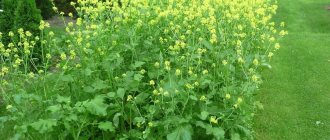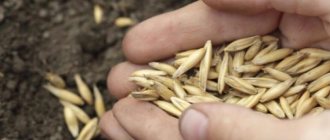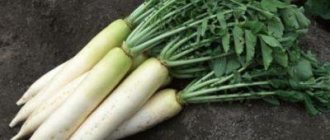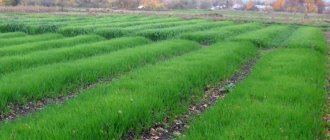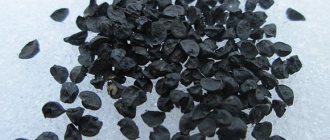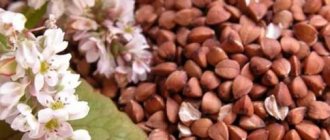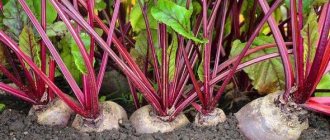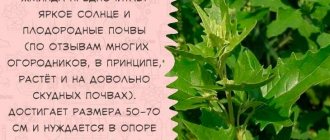Appearance and characteristics of the culture
The homeland of the annual oilseed radish is Asia. Now the culture is widespread.
Description of appearance:
- Plant. The height of the plant in adulthood is 1.5-2 m.
- Root system. Core, deeply penetrating. It has a thickened upper part with powerful branches on the sides. There is no root crop.
- Flowers. Appear in May. On loose inflorescences there are many flowers of lemon or snow-white color.
- Fruit. When the flowers fade, fruits form. There are 3-5 seeds in a pod. The pods do not burst, which allows harvesting in wet weather.
- Seeds. Small, spherical, reddish or brownish in color. 1 thousand pieces weighs about 12 g.
The seeds contain up to 50% fat. They are used to obtain vegetable oil, which is the raw material for the production of biofuel.
Characteristics of oilseed radish:
- suitable for growing in regions with difficult farming conditions;
- the yield of green mass with several cuttings is 200-600 centners per 1 ha.
Oilseed radish is a plant with versatile uses.
Successful management of crop production and feed production in modern economic conditions requires the expansion of the floristic range and the introduction into production of crops that do not require the development of high-cost technologies. Such a crop for the forest-steppe zone is oil radish (Raphanus satiuus ssp. oleifera Metzg.) - an annual herbaceous plant of the cruciferous family, capable of quickly growing a relatively large mass.
A harvest of 300...400 c/ha of phytomass is formed in 35...45 days. The green mass is characterized by a high protein content - up to 25.9% (corn 7...9%), fat - up to 4.5%, ash elements - up to 19.5% and a relatively low amount of fiber - 17...22%, rich in P, K, Fe, Zn, Mg, Ca and other trace elements. In the flowering phase, it contains up to 30 mg/kg of carotene and more than 600 mg/kg of ascorbic acid. There are 170...200 g of digestible protein per 1 feed unit (in corn it is 60...75 g with a zootechnical norm of 105...115 g), while the oil radish protein is well balanced in amino acids. The nutritional quality of the green mass is close to that of mixed feed and leguminous grasses such as alfalfa, clover, and sainfoin.
Oilseed radish is an indispensable crop for conveyor production of green mass. In the forest-steppe zone, when sown at different times during the summer, it can produce 3 harvests. It tolerates late sowing well and ensures the production of high-protein phytomass in the autumn (September, October). Ecologically plastic, grows well in extreme conditions. It produces yields of 300 c/ha even at the latitude of the Arctic Circle. Unlike other cruciferous crops (rapeseed, mustard), it is characterized by constant yields. The plant is biologically capable of regeneration; when mowed in the budding phase - the beginning of flowering, it grows back well and produces up to three cuttings. The length of the growing season is 90...100 days.
Radish can also be cultivated as an oilseed crop. Seeds contain up to 48...50% fat; The vegetable oil obtained from them is used for a variety of purposes, including the production of biofuel.
The root system of the plant is taprooted, highly branched, deeply penetrating into the soil, capable of extracting moisture and nutrients from the lower horizons. The stem is branched up to 130 cm high, well leafy. The leaves are large, up to 6...8 cm long and 4...6 cm wide. The inflorescence is a loose raceme, the flowering period extends to 30 days. The flowers are white or pinkish and are eagerly and actively visited by bees. Valuable honey plant. The fruit is a non-cracking pod. Thanks to this, harvesting can be carried out in the phase of full maturity of the seeds at optimal humidity, without the cost of post-harvest drying. Weight of 1000 seeds is 7…12 grams.
Oilseed radish is cold-resistant and tolerates long-term cooling down to minus 3...4 degrees Celsius, and adult plants up to minus 6...7 degrees Celsius. At a low positive temperature of 5...6 degrees, the plant continues to grow. Places moderate demands on moisture availability and soil fertility. It can grow on loamy and sandy loam soils with a slightly and even moderately acidic environment, drained peat bogs, and only does not tolerate flooding and high groundwater levels. Indispensable on heavy clay soils.
Photo. Seed plot of oilseed radish, variety Rainbow.
The advantages of oilseed radish include the fact that it well loosens, structures, drains both the cultivated and deep layers of the soil, and increases their air and moisture capacity. In addition, by effectively absorbing nutrients from the subsoil layer, it prevents their leaching and returns them to the upper layers of the soil. In the forest-steppe zone, the plant leaves behind root residues on average up to 85 kg/ha of nitrogen, 25 kg/ha of phosphorus and up to 100 kg/ha of potassium. This is one of the best crops for protecting soils from water and wind erosion in autumn and spring, and if not mowed, even in winter. Retains snow, promotes less soil freezing, that is, greater accumulation of moisture.
In modern economic conditions, oilseed radish must be considered as a strategic green manure crop capable of preserving the universally declining soil fertility. This is facilitated by the simplicity and relative cheapness of the technology for its cultivation, low consumption of seeds and their guaranteed production in any farm, and the rapid increase in a large amount of biomass.
The plant can be sown for green fertilizer both in early spring and in the second half of summer, mowing or stubbing, that is, after harvesting the main crop. This is especially important for farms with limited arable land. When phytomass is incorporated into the soil, it becomes an easily digestible organic fertilizer with a large supply of nutrients. It is estimated that with a green mass yield of 40 t/ha, the same amount of nitrogen, phosphorus and potassium can enter the soil as would be applied with 30 t/ha of half-rotted manure. But storing manure requires environmentally friendly and expensive storage. It needs to be loaded, delivered to the field and applied to the soil, and this is associated with large energy and monetary costs, especially when applied to remote fields and areas. In addition, not all farms may have its reserves. Decomposing in the soil, radish biomass increases the reserves of humus in the arable horizon, improves the living conditions of beneficial soil microflora and worms. This, in turn, leads to a reduction in plant diseases and an increase in the productivity of cultivated crops. The presence of essential oils in all parts of oilseed radish serves as a preventative against the accumulation of pests (wireworms), fungal diseases (rhizoctoniosis, potato scab, etc.), the development of nematodes and other pathogens.
It is also important that radish quickly shades the soil and effectively suppresses the development of weeds; it is considered the best clearer of unwanted vegetation from fields.
Oilseed radish quickly goes through the initial stages of development, therefore, despite the formation of large cotyledon leaves, it is less damaged than other cruciferous plants by leaf-eating flea beetles, and due to early flowering and a short period of vegetative development, it is weaker than rapeseed and is affected by the rapeseed flower beetle.
For feed, oilseed radish phytomass can be used fresh, as a green supplement or by grazing livestock in the summer and, most importantly, in the late autumn. It is used to prepare grass flour, granules, briquettes, haylage, and silage. However, due to the high protein content, green mass is difficult to ensile, so it is better to ensile it together with other carbohydrate crops. Radish, like rapeseed or white mustard, can be successfully cultivated as part of various mixtures of annual herbs. It is a good additional component for vetch-oat and pea-oat mixtures. It can be sown with corn for green fodder in the 3…4 leaf stage.
The results of our experiments show that it is most advisable to use this crop in multicomponent mixtures for green fodder and silage. Modeling such multispecies crops is an economically cheap and effective way to increase the production of feed protein and the yield of grass stands. We have tested four- and five-species cenoses, consisting of sunflower, oats, barley, peas or vetch and oilseed radish, in various soil-climatic zones of the Middle Volga region and the Urals.
The inclusion of oilseed radish in the composition of traditional sunflower-legume-cereal mixtures for silage in the forest-steppe zone makes it possible to increase the share of the legume component in phytocinosis, without fear of its lodging before harvesting. Thanks to its strong and branching stem, which does not have rigid drainage, radish is a good support plant for long-stemmed varieties of peas or vetch. Adding even a small amount of radish to the above mixture contributes to the formation of dense non-lodging grass stands with a green mass yield of 26.0...30.0 t/ha, balanced in digestible protein within 125...128 g per 1 feed unit.
Photo. Mixed sowing with oilseed radish.
Thus, in sharply contrasting weather conditions of 2011...2012, on an area of 60 hectares, we planted joint crops consisting of: sunflower 40% + peas 30% + oats 25% + barley 25% + oilseed radish 30% (in % seeding rate from that recommended for single-species crops) in the Krasnaya Zvezda agricultural production complex in the Isaklinsky district. Under conditions of uneven moisture (HTC 0.30...1.04) on leached chernozem, on average over three years, 24.6 t/ha of green mass and 0.56 t/ha of digestible protein were obtained. This is respectively 2.3 t/ha and 0.24 t/ha more than in the sunflower grass stand compacted with vetch-oats. Feeding combined silage to livestock made it possible to increase the productivity of the dairy herd by 13.0% and the fat content of milk by 10.3%.
The results of our research are reflected in the feed production system of the Iskra collective farm in the Klyavlinsky district. The expansion of crops of sunflower-bean-oat mixtures with oilseed radish contributed to the creation of a strong feed base, guaranteeing an annual production of 3.5...4.0 tons of feed units per conventional head, which led to the stable and dynamic development of livestock farming. Since 2010, in the agricultural production complex "Luch" in the same area, sunflower with peas, oats, barley and oilseed radish has been successfully cultivated for the production of green fodder and silage by sowing a mixture of seeds in early spring with one pass of an ordinary seeder. Replacing the sunflower monoculture with a polyspecies mixture increased the yield of dry matter by 5.2...8.8% and increased the yield of digestible protein per 1 ha by 24.0...50.5%.
Photo. Inspection of experimental crops at Aksenovsky agricultural plant.
Agrocenoses of sunflower for silage along with peas, oats and oilseed radish, planted on an area of 105 and 124 hectares in the collective farm named after. Tukay Northern region, on average for 2011...2012. in contrasting weather conditions with a HTC of 0.72...1.10 on medium-thick leached chernozems, they provided an average of 25.0 t/ha of green mass per 1 ha, 0.52 t of digestible protein with its concentration in 1 feed unit ranging from 110...115 G.
The crops of oilseed radish for green mass and seeds in the educational farm of the Federal State Budgetary Educational Institution of Secondary Professional Education Aksenovsky SHT (2009...2013) located in the Pre-Ural forest-steppe were distinguished by consistently high yields and economic efficiency. The yield of green mass with the usual row sowing of the crop varied from 22.0 to 36.5 t/ha over the years, and this was without the application of mineral fertilizers. The productivity of seed grass stands, with a seeding rate of 20 kg seed per 1 ha, was 8...12 c/ha. The seed harvest from 1 hectare is enough to sow 40...60 hectares, and as part of mixtures for food 120...150 hectares. And today the technical school is ready to transfer part of the stock of seed material to production.
We hope that the presented material will arouse the interest of managers and specialists in this plant. For our part, we are ready to share our accumulated information on the specifics of technologies for cultivating oilseed radish for feed and seeds. You can buy seeds by contacting the Samara State Agricultural Academy - Russia, Samara region, Ust-Kinelsky village, by phone: +7 (84663) 4-62-42, 8-902-320-21-51.
Trots V.B., Doctor of Agricultural Sciences, Professor; Abdulvaliev R.R., candidate of agricultural sciences; Khismatov M.M., applicant; Safarov Z.F., applicant; FSBEI HPE Samara State Agricultural Academy, Samara region, Ust-Kinelsky settlement. 01/11/2014
The best varieties
Breeders, developing new varieties of oilseed radish, are working to increase its honey production, enlarge the root system, and improve its green manure properties.
Tambov resident
This is an old proven variety, bred about 40 years ago. Resistant to frost and drought. Able to withstand temperatures as low as minus 5°C. The stem is distinguished by strong foliage, so the variety is advantageous to use as food.
Nika
Created by Belarusian breeders by crossing previously bred varieties. Productivity – 2.5 tons per 1 ha. The growing season is 90-120 days.
Brutus
German variety with a growing season of 90 days. Resistant to blackleg. This is a medium-sized variety, reaching a height of 1.2 m.
Sabina
High-yielding Belarusian variety. Produces a lot of seeds. Up to 3.5 tons are collected from 1 hectare. They are used in complex plantings with peas and silage corn. Also added to silage.
Description
An annual plant belonging to the Brassica family. Unlike garden radish, oilseed radish is not eaten. It is grown as a fodder and honey crop . The root of the plant is taprooted, branched, and thickened in the upper part.
Straight branched stems, reaching a height of up to 120 cm, can lay down heavily. The leaves are pinnately divided, loose inflorescences contain small flowers, the colors of which can be varied: white, light lilac, pink, pale purple. After flowering, pods containing reddish small round-oval seeds are formed. One thousand seeds weigh 8–12 g.
Advantages and disadvantages
Oilseed radish is an important industrial crop with many advantages and only a couple of disadvantages.
Pros:
- Ability to grow on heavy, clay soils.
- Increases fertility. If radishes are not mowed before winter, they can trap snow and prevent the soil from freezing.
- All parts of the crop contain essential oils, the characteristic odor of which prevents the proliferation of pests in the soil - nematodes, wireworms.
- Increases the number of earthworms and beneficial microorganisms.
- Tolerates cold, drought and high humidity.
- It has stable productivity.
- Tight closure of crops prevents the growth of weeds.
- Green manure, being mowed, nourishes the earth with humus.
- Continues growing season at +5…+6°C.
- Not afraid of frost down to minus 4°C. Stronger plants can tolerate temperatures as low as minus 7°C.
Minuses:
- Does not grow well in acidic soils. Before sowing radishes, add wood ash or slaked lime to the area.
- It is difficult to make silage from the crop, since its leaves and stems contain a lot of essential oils, so preservatives are added to the silage.
Flaws
- The need to lim the area, since oilseed radish does not grow well on acidic soils - and the resulting alkaline environment is not suitable for all crops.
- The need for intensive watering during the period of seed hatching, before and during flowering.
- Difficulties in preparing oilseed radish silage are due to the large amount of essential oils in the leaves and stems, and the need to add preservatives to the silage, otherwise it will ferment.
When to sow radishes?
Oilseed radish is sown in rows. Radish can be sown from April to September, but the highest yield is typical for April sowings.
Autumn
When sowing winter crops, you must have time to remove the green manure. There should be a short time interval between mowing the radishes and sowing winter crops so that the green mass has time to rot. Moreover, the grass must be mowed before the seeds form.
In autumn, the seeding rate is doubled. The autumn norm is from 4 to 8 g of seeds per 1 square meter. m. This planting allows you to increase the density of crops.
Spring
Sowing starts in April or earlier. You need to focus on the soil temperature. If it has warmed up to +10°C, you can start sowing. If the temperature is unstable - from time to time it drops below the specified minimum, then it is recommended to increase the seeding rate.
Summer
With the arrival of summer, sowing can be done at any time. Plantings are watered during the sprouting period. You can sow areas immediately after harvesting vegetables.
When the time comes to sow greens - salads, arugula, etc., the radishes will already be mowed, and the soil will be enriched with useful elements.
Oilseed radish is planted in front of:
- cucumbers;
- tomatoes;
- pepper;
- potatoes;
- raspberries;
- strawberries;
- grapes
Oilseed radish cultivation technology
When sowing oilseed radish, you must:
- select the landing date;
- prepare the site;
- comply with agrotechnical rules.
Preparing the landing site
When planting grass for livestock feed or as green manure, it is necessary to prepare the area. To do this, in cloudy weather, the ground is loosened or slightly dug up. To use the crop as green manure, the seeds can be sown on depleted soil; if, as feed, the planting material is better sown in fertilized soil.
Important! When planting seeds on a hot, dry day, germination rate is reduced by 2 times.
How to plant oilseed radish
If the oilseed crop is grown as green manure, then per 1 sq. m consume about 2 g of planting material, when growing a crop for livestock feed per 1 sq. m consume about 5 g of seeds.
Planting oilseed radish:
- As green manure, sowing is carried out in cloudy or rainy weather using the scatter method. This method will allow you to sow the seeds evenly and get vigorous shoots.
- For industrial purposes, crops are planted in rows to a depth of 3-4 cm. The interval between the beds should be at least 15 cm.
- If grass is grown for livestock feed, then it is sown together with peas in a ratio of 1:5.
- As a honey plant, the plant is sown in rows, the width between rows should be at least 40 cm.
Important! Sowing oilseed radish under winter rapeseed is not recommended, since the plants have common diseases and pests.
Caring for oilseed radish
After sowing, seed germination begins on day 4-5. After 30-40 days, the plant forms a full-fledged basal rosette, which will bloom in 2 months. The crop does not require moisture, fertilizing or loosening throughout the growing season. If it grows on slightly alkaline soil, then it can be fed with organic fertilizers. Since plant development and productivity depend on this.
Is it necessary to dig up oilseed radishes in the fall?
Green manure can be dug up, and late plantings are left unmowed throughout the winter. Roots and shoots will hold the snow cover, retain moisture, and prevent the soil from freezing to great depths. In the spring, the overwintered plant rots and turns into natural organic fertilizer, which saturates the soil with necessary micro- and macroelements.
Digging is done 45 days after seed germination. An important rule is not to miss the moment of flowering so that the insemination process does not occur. If the crop has bloomed, then the radish is mowed and placed in a compost pit.
When digging, the green part is mowed down, the stems are crushed and the ground is dug up. Green mass can also be used as:
- mulch;
- component for a compost pit;
- feed for livestock.
Important! Digging of oilseed grass is completed 14 days before the onset of autumn frosts.
Site selection and preparation
Radish is unpretentious and undemanding to the composition of the soil. However, to achieve this goal, it is necessary to bring the area intended for sowing into compliance with agrotechnical standards.
How to improve soil quality:
- a deoxidizing agent – slaked lime or dolomite flour – is added to soils with high acidity;
- It is recommended to add a mineral complex or organic matter to soils with low fertility.
The soil for radish can be plowed or dug up, depending on the scale of the crop. A small area can also be loosened using a flat cutter.
Plowing is more necessary for heavy clay soils; for others, surface loosening is sufficient. Planting depth – 4 cm.
To increase productivity, the soil can be fertilized with a preparation containing microorganisms - “Baikal EM-1” or “Siyanie-1”. You can also add organic matter to the soil to increase fertility.
Features of planting and growing as fertilizers
Oilseed radish should be planted in early spring or mid-September. If you plant a plant in mid-August, it will only be able to fertilize the soil by half. This is due to the low germination of green mass. Planting material for oilseed radish should be buried 2-4 cm into the soil. A distance of 15 cm should be maintained between the rows. Lightly compact the top layer of soil.
Find out when to sow phacelia in a greenhouse as green manure in this article.
Before adding green manure seeds to the soil, mix them with sand. You will be able to see the first shoots in 4-7 days. Next, you will need to regularly water the plant.
When abundant green mass has grown, but flowering has not yet begun, the oilseed radish needs to be mowed. Using a shovel, they are crushed and dug up with soil. In order for the fertilizer to become a complete nutrition for the soil, then perform the process of humification. Decomposition of green mass is carried out in moist soil for 2-3 weeks.
What reviews there are about the use of buckwheat, and how positive they are, this material will tell you.
On the video - how to grow oilseed radish:
You can speed up fermentation with the help of EM preparations. Water the green mass with the solution before cultivation. When the plant particles begin to disintegrate, they will become an excellent, easily digestible fertilizer. The area is filled with humus and organic matter.
You can fill the soil with nutrients using another method. For these purposes, green manure must be prepared as compost. In early spring there will be excellent humus on the site. It must be used for its intended purpose. The roots that remained in the ground over the winter can improve the condition of the soil before the first planting.
What green manures should be used for cucumbers in the spring, and what they look like, as well as what they are called, is indicated here.
How to sow oil radish?
The rate of seeds for sowing depends on:
- Sowing time. In autumn and spring, the norm is increased by 1.5-2 times. Conditions at this time are not the most favorable, and germination may decrease.
- Sowing technologies. There are two ways to plant radish seeds:
- In the ranks. Sowing rate – 2-3 g per 1 square. m.
- Scattered. 3-4 g per 1 sq. m.
To sow 1 hectare, 20 to 40 kg of oilseed radish seeds are required.
Features of sowing:
| Target | Spacing between rows, cm |
| Feed | 15 |
| Green manure | 15 |
| Honey | 25-20 |
| Seeds | 20 |
Growing oilseed radish
The answer to the question “when to plant oilseed radish” depends on your goals. It is possible to sow seeds from April to mid-September. Plants planted in April give the highest yield. For food and as a green manure, radishes are sown in rows every 15 cm. Seed consumption is 2-3 g/m2. Sowing depth – 2-4 cm.
Late sowings require more seed consumption. When sowing after August 10, the norm is doubled, since plant growth slows down significantly in the fall. Late sowings are not suitable for green manure.
When mixed sowing with spring vetch, use a ratio of radish and vetch seeds of 1:6. With this scheme, the radish stems serve as supports for the climbing plant.
For honey collection and for seeds, oilseed radish is sown in row spacing of 40 cm.
The first shoots appear after 4 days, and after 40-50 days you can make the first mowing for fodder. Flowering occurs approximately 40 days after germination.
When greening for winter crops, radish is cut 3 weeks before sowing.
For rotting and the formation of humus from green mass, the soil must be moist.
When preparing the soil for spring sowing, radishes are left until frost.
Seeds are collected in late autumn. The pods retain their shape, and the seeds dry naturally, which saves the cost of artificial drying.
In Russia you can buy oilseed radish seeds of popular varieties: Sabina, Nika, Prygazhunya, Brutus, Raduga, Tambovchanka.
Care
Seeds sown in the ground begin to germinate on the 4-5th day. And after 30-40 days, the plant forms a rosette, which blooms 60 days after sowing.
During the growing season, the crop requires virtually no care. The only thing that may be needed is fertilizing with organic matter if the soils are infertile.
When industrially growing crops, the following activities are carried out:
- after sowing, roll the soil;
- if necessary, harrowing before emergence;
- weed control.
The biggest enemy of oilseed radish is the cruciferous flea beetle. They fight it with insecticidal drugs. Also among the crop pests are cabbage moth and cabbage fly. And the most common diseases are powdery mildew and peronosporosis.
What is it used for?
Ideal green manure
Perfectly improves poor, depleted, clay soil. If the land is intensively exploited, even the use of complex mineral fertilizers is often not enough. In this case, natural fertilizers will provide invaluable help.
Green manure, which includes oilseed radish, is a source of nutrients for main crops; their use is necessary to improve the health of the soil with rapid crop rotation. Thanks to its powerful root system, oilseed radish loosens even the densest soil with a high clay content, transfers hard-to-reach nutrients from the deep layers of the soil to the upper layers, causing its fertility to rapidly increase.
This plant is effective for protecting soil from erosion - washing away useful substances by rain and wind. If you do not remove plants for the winter, they will retain snow and the soil will be saturated with melt water in the spring.
Thanks to the content of a number of essential oils, oilseed radish perfectly rids the soil of wireworms, a number of fungal diseases, for example, potato scab and rhizoctonia, which causes indelible black “dirt” on the peel.
Dense foliage suppresses the growth and development of weeds, especially wheatgrass. After mowing, radish tops serve as a breeding ground for earthworms and beneficial microorganisms.
Important: oilseed radish cannot be used as a precursor to cabbage, radish, or daikon. This will lead to an increase in the number of pests and additional depletion of the soil!
Forage plant
The two main advantages of this variety of forage crops are early maturity and high yield. Also, thanks to its unpretentiousness in cultivation and resistance to frost, the cultivation of oilseed radish allows animals to be walked on pasture until late autumn.
Radish is nutritious, rich in protein, produces a lot of green mass, which can be given to livestock both fresh and as silage, grass meal, briquettes. For food, it is better to plant it with legumes, cereals and sunflowers.
Honey plant
Thanks to its long flowering period, oilseed radish is an excellent honey plant. Even in the cool season, the flowers of this plant are able to produce nectar and attract bees. Honey has a very pleasant smell and thickens very quickly, so it is not recommended to leave it in honeycombs over the winter.
In cooking
There are special salad types of oilseed radishes brought to Russia from South Korea. They feel great in the cool season, which allows them to be grown from early spring to late autumn.
Leaves after flowering lose their value, so they should be used for food before flowering, usually 4-5 weeks after planting.
The classic recipe for vitamin radish salad includes:
- 3-4 small plants (cut the stems at a distance of about 3 cm from the ground);
- cucumber;
- green onions;
- vegetable oil;
- salt.
Other varieties of vegetables are often used in cooking, which include daikon, green, black, watermelon and Margelan radish (Loba). There are separate articles about all of them on our website.
In pharmacology
In pharmacology, essential oils and essences are used to produce vitamin complexes. Oilseed radish is also often included in herbal preparations.
For your information! This tea perfectly relieves stress and eliminates headaches.
In cosmetology
Essential emulsions from this type of radish are usually added to massage oils. These oils have a slight warming effect and promote relaxation. Balms and conditioners with essential rare oil give hair a pleasant honey smell and make combing easier.
Should you dig up oilseed radishes in the fall?
Radishes are dug up before winter or left for the winter. If sowing was done late, it is recommended not to dig up the radish.
Radish left for winter:
- traps snow on the field, allowing the soil to accumulate more moisture;
- accumulation of moisture prevents soil freezing.
In the spring, as soon as the snow melts, the above-ground part of the plants begins to rot, enriching the soil with useful elements.
If you dig up radishes, then this should be done 45 days after sowing. It is important to dig up the crop before flowering begins. If time is lost, the cut stems are not left on the field, but are put into compost to remove seeds from the field.
To make it more convenient to dig up the soil, the radish must first be mowed. If the work is carried out manually, the plant stems are crushed with a shovel and dug up, embedded in the ground.
Digging of oilseed radishes should be completed two weeks before the onset of frost.
Oilseed radish as a honey plant
Oilseed radish is a recognized honey crop. Its main advantages are long flowering (up to 30 days) and the release of nectar in cool weather. Honey harvesting occurs in early spring and mid-summer, when other honey crops have already bloomed. The content of sucrose, fructose and glucose in nectar is 20%. Honey has a strong aroma and high medicinal properties.
Due to rapid crystallization, it is not recommended to leave rare honey in honeycombs for the winter.
Bees prefer to visit the sparse field in the morning and in cloudy weather. In the morning, flowers bloom at 6-7 am.
Mowing
Radishes are mowed a month after germination. If the crop is planted as green manure, mowing is carried out 30 days before planting vegetable crops.
Harvesting the crop for food begins at the budding stage and ends before the pods form. Mow the stems, leaving a cut 6-7 cm high, so that they grow faster.
Harvesting for seeds begins after the pods have fully matured. The finished seeds are light brown or red-brown in color, depending on the variety. Store the seed in paper or linen bags.
What else to consider when cleaning:
- If you mow the crop when it reaches a height of 20-30 cm, then you can get green mass three times during the season.
- If the crop is planted before sowing winter crops, then mowing should be done 20-25 days before sowing the seeds.
- To obtain humus from plant mass, it must be moistened.
- If the crop is used as a preparation for spring sowing, it is harvested after the first frost.
Mowing and plowing
For green manure, the plant is always cut before the seed formation phase begins. In beds intended for planting winter vegetables and herbs (garlic, carrots, parsley, beets, dill, etc.), oil radish greens must be plowed in no less than 20-25 days. During this time, the biomass has time to decompose and saturate the soil with all the necessary mineral salts. Therefore, if you plan to plant in mid-October, then plowing the radishes should be done no later than September 25th.
Plants are pruned using a flat cutter or a cultivator. As practice shows, to speed up the processes of decomposition and fermentation, as well as to create improved microbiological conditions for beneficial microorganisms and earthworms, before plowing it is useful to spill the biomass with a solution of EM preparations, for example, Baikal.
According to reviews from experienced agricultural technicians, root residues decomposing in the soil and plowed biomass enrich the soil with the following minerals: up to 85 kg of nitrogen substances, up to 25 phosphates and up to 100 kg of potassium per hectare of area.
After greening, the beds begin to be used after 3 weeks. If you sowed a plot of garden with radish in April, and harvested the crop before the end of June, then in mid-July you can plant leafy greens (arugula, dill, coriander, parsley for greens, onions for feathers), beans, peas, lentils, and also early ripening vegetables, such as radishes.
But for maximum efficiency on lands left fallow, experienced summer residents re-sow oilseed radish or its mixture with vetch in mid-summer. After this approach, the next season the fertility of the soil, even the most depleted one initially, is completely restored, and the soil on such plantations is ready to fully accept vegetable and berry crops, is free from perennial weeds, pests and parasites, is well structured and has excellent aeration and moisture permeability.
When planning planting in the garden, do not forget that oil radish is not planted before or after cabbage. For the rest of the plants, preliminary greening of the beds with this cruciferous crop brings undoubted benefits, having a beneficial effect on increasing productivity. Silerate also has undoubted value as a means of restoring the balance of nutrients, as well as structuring uncultivated lands.
Main Applications
Due to its properties and qualities, oilseed radish can be used for various purposes. Requiring no special care, hardy and unpretentious, this crop is a generous honey plant, fodder and green manure.
Areas of application of oilseed radish:
- Green manure. Soil enrichment occurs in two ways. Thanks to powerful roots that pull up nutrients from the deep layers of the soil. Greens turn into fertilizer containing humus and organic matter. The culture protects the soil from erosion. It also improves soil looseness, air and water permeability.
- Phytosanitary. Essential oils protect not only the plant itself, but also the soil in which it grows from insects and fungi. The culture helps eliminate potato scab, nematodes and wireworms. By shading the soil, it suppresses the growth of weeds. Oilseed radish is actively used in weed control.
- Fodder crop. On average, 30-70 tons of green mass are collected from 1 hectare. No more than 50 days pass from sowing to the crop being ready for mowing. You can mow radishes three times in one season. The green mass is fed to livestock fresh and also in the form of silage. Also, haylage is made from oilseed radish. It is part of various herbal mixtures.
- Honey plant. Oilseed radish produces nectar even on cold days. Plants are ready for honey harvesting in early spring and summer. The nectar of the culture contains sucrose, fructose and glucose - in an amount of 20%. Radish honey is very aromatic.
Oilseed radish as green manure
The use of oilseed radish as green manure has in recent years acquired strategic importance due to large-scale soil depletion.
Soil protection and enrichment
Oilseed radish has a powerful root system. The long root ensures the rise of nutrients from the lower layers of the soil to the surface. Rotting, mowed green mass is transformed into fertilizer rich in humus and organic matter.
Pancake week radish is one of the most effective crops used to protect the soil from erosion in spring and autumn, and if the plants are not removed for the winter, they retain snow, promoting the accumulation of moisture in the soil and less freezing.
The culture has a good effect on the structure of the soil, loosening it and providing drainage even in deep layers. As a result, the moisture and breathability of the soil increases.
From the remains of roots, the soil is enriched with mineral elements. On average, per 1 hectare of area it includes:
- nitrogen – 85 kg;
- phosphorus – 25 kg;
- potassium – 100 kg.
Phytosanitary qualities
The content of essential oils in the plant helps to resist pests and fungal diseases. Oilseed radish is used for preventive control of wireworms, potato scab, rhizoctania blight, and nematodes. Dense foliage shades the soil well and suppresses the germination of weeds. Oilseed radish is the main crop used to control difficult-to-control weeds such as wheatgrass. Rotten tops serve as an excellent breeding ground for worms and other biological organisms that have a beneficial effect on the soil.
Oilseed radish cannot be used as green manure as a precursor to cabbage.
Where else are radishes used?
In addition to agronomy, oilseed radish is in demand in:
- Cooking. An inedible, at first glance, product can be used for vitamin dishes. Radish leaves soaked in water make an excellent base for salads. Duration of soaking – 1 hour. Green shoots can be added to cabbage soup. They contain ascorbic acid, which saturates dishes with vitamin C.
- Food industry. Radish contains unique essential oils, which makes it possible to obtain enriched vegetable oil from the crop. True, this process is labor-intensive and produces very little oil. Protein is used to produce sports nutrition. Radish leaves should not be overused; they contain glucosides that can cause poisoning.
- Pharmacology. Essences obtained from radish serve as the basis for the production of medications. They are mainly used to make vitamins. Herbal infusions that have a calming effect are prepared from the green mass. Drinks based on rare leaves relieve stress and relieve headaches.
- Cosmetology. Essential mixtures obtained from oilseed radish are added to massage oils. Products with rare emulsions have a relaxing and mild warming effect.
- Production. Diesel fuel oil used in combines and other technical machines is obtained. It is also used to make an anti-corrosion emulsion.
Oilseed radish: description and features
Oilseed radish: photo
Oilseed radish appears to us in the form of a plant; its height varies from one to one and a half meters. The leaves have an indistinct, rather more jagged shape. The oilseed radish fruit is not a root vegetable at all. Of particular value is the pod up to eight centimeters long, which contains a number of seeds. Unlike ordinary root radish, oilseed radish simply does not have such a root vegetable. The root of the oilseed radish is a thickened rod from which a number of branches emanate. At the same time, the root is quite strong and large, and can withstand even the most dramatic temperature changes. In general, we note that the advantage of oilseed radish is that it can easily increase its own green mass even when the weather is very cold and unstable outside. For many crops, such weather can be destructive, but not for oilseed radish.
At the same time, the oilseed radish variety is excellent for planting this radish at a rather late time. It is completely unpretentious when it comes to climatic conditions, as well as the composition of the soil. As practice shows, oilseed radish can be perfectly cultivated even on very heavy and clayey soils, and it tolerates excess moisture or periods of severe drought. It is calm in such conditions and produces an excellent harvest in the form of pods, which are used in a wide variety of, but at the same time vitally important, areas.
In this article we will look in more detail at the characteristics and features of oilseed radish, tell you how it is cultivated, and what exactly it is suitable for in a person’s daily life and in his professional activities, if we are talking about certain areas. This radish really has many features and advantages that cannot be ignored, and we will talk about them.
Oilseed radish: reviews
Reviews
★★★★★
Leonid B., 67 years old, pensioner, Kursk region. Thanks to oilseed radish, I was able to revive a completely depleted plot.
It took three years to restore fertility. ★★★★★
Anton D., 58 years old, amateur gardener, Murom. I grow oilseed radish under strawberries.
Before planting the berries, I sowed green manure for two years before winter. On soils fertilized with radish, the berries ripen very tasty. I also use the crop to feed fruit trees. Hide
Add your review
By using oilseed radish as green manure, you can save on mineral fertilizers. Thanks to this hardy, practically maintenance-free crop, you can not only significantly improve the quality characteristics of the site, but also obtain vitamin-rich feed for livestock.
0
0
Copy link
Description of culture
Oilseed radish is an annual plant that can be grown for a variety of purposes. Oilseed radish is a fast-growing crop that can be sown several times a year. It has good frost resistance characteristics.
Chinese radish
The growing season is about 2 months for spring sowing, and 15-20 days shorter for summer sowing. The seedlings tolerate frosts well, which do not exceed -5 degrees, and during the flowering period they can withstand temperatures dropping to -8. That is why it is used as the final crop of the green conveyor when preparing feed. After mowing, the plant regrows and a second cut can be obtained.
It is used in:
- Food Industry;
- agriculture as fertilizer;
- cosmetology;
- pharmacology;
- cooking;
- biofuel production.
Important! Oilseed radish is not suitable for use as food, since as a result of its growth, fruits are not formed, like ordinary radishes. The fruit of the plant is a small pod with seeds.
The culture is distinguished by its unpretentiousness to conditions - radish can grow equally successfully both in cold regions and in places with a warmer climate.
At its core, oilseed radish is a plant 1.2-1.5 m high. It is distinguished by leaves that have a peculiar rugged shape. Each variety of oilseed radish blooms differently, ranging from white to pink or light purple. As already noted, the fruit becomes a small pod (6 to 8 cm) filled with seeds. The seeds have a round-oval shape and are colored red-brown. The weight of one seed is insignificant; for 10-12 grams you will need about a thousand pieces.
The seeds are very light
Despite good drought tolerance, sufficient moisture is required for productive growth, since the root system is located in the top layer of soil. If there is not enough moisture during growth, the plant will not branch and grow in height.
Fertilizer sowing technology
Sowing oilseed radish is not a complicated process, but you need to know some features.
Oil radish seeds
Calculation of the number of seeds
The standard amount of seeds for sowing is no more than 3 g per 1 m².
Quantity depends:
• from the time of sowing;
• technologies: planting in rows (2-3 g per 1 m²) or scattering seeds over the sown area (up to 4 g per 1 m²).
When sowing in early spring, you can increase this rate, taking into account that the soil has not yet warmed up enough, and germination may be slightly worse than when sowing in late spring or summer.
Choosing a place and time for sowing
Despite the unpretentiousness of the crop to soils, it is necessary to evaluate the composition of the soil on the site, since in some cases it will be necessary to carry out additional work to improve it:
• If the soil is acidic, you will need to add dolomite flour or lime.
• Depleted soils must be pre-fertilized with mineral complexes.
Adding lime to the soil
The most abundant harvests can be harvested when planting from May to August. Early sowing of green manure in April and late sowing at the end of August or autumn in September will affect the overall yield of the crop - it will be lower than in spring and summer. It is necessary to choose when to sow oilseed radish as green manure depending on the capabilities of the gardener and the goals that he sets for himself.
Soil preparation
The cultivation technology is quite simple. Before sowing, you need to prepare the soil: dig it up or treat it with a Fokin flat cutter. The main task is to make the soil loose so that the seeds can be planted and they can quickly hatch and sprout. When choosing the depth of processing, it is necessary to take into account that the seeds are planted to a depth of up to 4 cm.
Digging the soil
Seeding
Sowing in rows will require “cutting” furrows. The intervals between rows are selected depending on the purpose of growing the crop:
• as green manure - at least 15 cm between rows;
• as a honey plant - up to 20 cm;
• for obtaining seeds - up to 20 cm.
To make planting more convenient, the seeds can be mixed with sand and evenly distributed over the furrows or area allocated for green manure.
When scattering seeds, it is necessary to loosen the soil with a flat cutter.
In the spring. The earliest time for sowing radishes in the southern regions is April
It is important to remember that if the soil has not warmed up to +10°C, it is necessary to increase the seed sowing rates
Spring sowing of oilseed radish in furrows
In summer. During the summer months, green manure can be sown at any time
During especially hot periods, it is important to remember about additional watering at the time of seed germination. As a rule, gardeners sow radish beds immediately after harvesting early-ripening vegetables and in order to prepare for replanting, for example, early-ripening green crops: lettuce or arugula
In autumn. The timing for autumn sowing depends on the gardener’s goals. If it is necessary to plant winter crops after harvesting green manure, then it must be sown in such a way that there is time to harvest it, while giving it time to rot. On average, at least 3 weeks should pass from the moment of planting in the soil to planting winter crops.
If a gardener plants green manure to improve the structure and fertility of the soil, then in this case the radish can either not be removed at all and left in the beds. We remember that approximately 40 days should pass from sowing to flowering, and we obtain sowing dates for the middle zone in the second half of August.
Oilseed radish in the beds
Oilseed radish - an effective fertilizer for the soil
Almost every summer resident grows radish in his garden in order to have a very healthy and tasty root vegetable in stock in winter, which saves him from severe colds. However, there are also varieties that are not capable of forming fruits, but are valuable for their branched foliage and inflorescences. These varieties of seeds are sown to obtain green manure fertilizers.
Inherent qualities of oilseed radish
Oil radish (Raphanus sativus. Var. Oleiformis) is famous for its special fertilizer properties.
This is a cruciferous, annual plant. This crop does not form a root crop, like a regular radish, but goes deep into the soil cover with a developed strong root system, due to which a large number of leaves are formed on the surface. Oilseed radish reaches a height of up to two meters.
Its foliage can be used for food; housewives especially often prepare salads from the tender leaves. But overgrown stems are an excellent fertilizer for the soil, the so-called green manure. This crop is not picky about growing conditions. She is not afraid of drought, cold, or excessively wet conditions.
It is not necessary to plant radishes in well-lit, sunny places; they will also yield excellent crops in shaded areas. The time of vegetation development from planting to the appearance of the first inflorescences is forty days, and this makes it possible to grow radishes several times during the favorable spring-summer-autumn season. The later the radish is sown in the soil, the greater the seed consumption, and their germination rate decreases. There are about thirty grams of seeds per ten square meters. Seed material is sown by scattering the seeds over a certain area and planting them with an ordinary light rake to a depth of about two centimeters for excellent germination.
The effect of using oilseed radish as a fertilizer
- Sowing oilseed radish is mainly associated with the desire to improve the soil structure in garden beds and make it more nutritious for all the necessary nutrients and organic elements. The well-developed root system of radish helps to raise the most useful minerals into the upper layers of the soil, so necessary for the vegetable crops that are grown at home in ordinary garden plots. After the shoots reach their maximum height and finish flowering, they are mowed down, and the area with the roots is dug up using the usual manual method using a garden bayonet shovel. From green, non-coarsened stems, a green crushed mass is prepared, which is dug into the soil. If the stems have aged and become coarse, compost is prepared from them.
- Oilseed radish very effectively fills the land, does not allow weeds to break through, due to which nothing else grows in the beds except vegetables and radishes. It is radish that today is an excellent method of weed control in large agricultural plots and fields.
When is the best time to use oilseed radish as fertilizer?
This crop is most often grown on loamy soils, peat bogs, slightly acidic areas, vineyards, which helps to destroy malignant pathogens in the soil, wireworms and fungal diseases for a period of three to six years, loosening the enriched soil, its drainage, accelerating the growth of shoots of other crops , causing improved air and moisture capacity. Radish is used as green manure to enrich the soil with the missing amount of nitrogen, potassium, calcium, phosphorus, as well as in areas that are too contaminated with weeds, especially those dotted with wheatgrass. Another important property of oilseed radish is the ability to protect the soil from water and wind erosion, especially in autumn and spring.
Step-by-step instructions on how to plant in the ground
The soil must first be loosened; deep digging is not required. A Fokina cultivator or flat cutter will do an excellent job. It is advisable to plant on a cool, rainy day. When planting in hot weather, seed productivity can be halved. The sowing depth is 2-4 centimeters, the distance between rows is 0.15 meters - if the purpose of sowing is green manure or growing livestock feed, 40 cm - if planting is for honey collection or obtaining seeds.
For ease of sowing, seeds can be mixed with coarse sand; on an industrial scale, a CH-16 seeder is used.
We invite you to watch a video on how to plant oilseed radish on your site:
